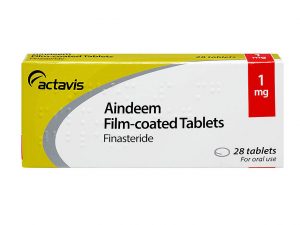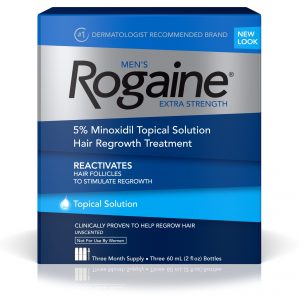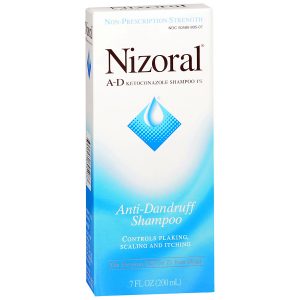Hair loss (alopecia) affects both men and women due to various causes. A highly prominent type is male pattern baldness, also known as androgenic alopecia. This form of hair loss can begin at any age post puberty and slowly progresses over time. Most men in their lifetimes will be affected by this form of hair loss. The focus of this article is to look at the different types of hair loss with heavy emphasis on androgenic alopecia; as well as evidence based treatments for male pattern baldness.
Types of Hair Loss
Androgenic Alopecia (Male Pattern Baldness)
Roughly one half of males by age 50 will be affected by male pattern baldness, also known as androgenic alopecia [1]. As males produce testosterone, the enzyme 5-alpha reductase (of which there are 3 types) can convert it to dihydrotestosterone (DHT) [2]. The hair follicles (which express these enzymes) at certain regions of the scalp then undergo inflammatory damage due to the DHT. This degrades the hair follicles themselves over a relatively long period of time which leads to a process of hair thinning and hair loss [3].
Variable levels of total and free testosterone are seen in men with androgenic alopecia. Though whether or not it actually occurs has to do with 5-alpha reductase expression in the scalp. Regardless of the levels of testosterone and external DHT, if the scalp is not susceptible to expressing the enzyme and ultimately being damaged by DHT then the hair follicles will stay healthy. The level of 5-alpha reductase expression is one major reason why men bald at various rates and timelines [4].
External use of testosterone and other anabolic steroids (AAS) will generally cause balding in males who are already genetically susceptible. Essentially, it puts the user on an accelerated timeline but will not be a definitive trigger in most males. It is important to remember that treatments aimed at 5-alpha reductase will not work at preventing hair loss from DHT derived AAS. Also, certain AAS have been anecdotally linked to hair loss despite not being DHT derived.
Common myth: You can onlyinherit the genetics for this condition from the mother’s side. This is entirely false.
Telogen Effluvium
The average person can lose a bit over 100 hairs a day. A significant increase over that number can be defined as telogen effluvium. Many etiologies exist for this condition, including chronic medical issues, major stress, drugs (including AAS) and other things. Once the cause is stopped, the hair loss is usually reversed [5].
Alopecia Areata
This condition leads to a localized balding region (bald spot) due to an autoimmune effect. It is believed that T cells induce an inflammatory effect that is highly localized on the scalp. The person develops a bald spot/patch but the rest of their hair is unaffected [6].
Anagen Effluvium
This form of hair loss is due to chemotherapy. This is usually reversible after treatment is completed [7].
Traction Alopecia
As the term suggests, this occurs due to pulling forces on the hair. Effectively, this affects those with ponytails or any style that places excessive force on the hair [8].
Other causes of hair loss include: scarring alopecia, trichotillomania (pulling out one’s hair), bacterial & fungal infections (tinea capitis), hypothyroidism and hyperthyroidism and many other less common etiologies.
Treatments – Male Pattern Baldness
There are numerous treatment modalities and regimes for androgenic alopecia. The methods of treatment generally involve inhibition of the 5-alpha reductase enzyme, directly stimulating hair growth, and trying to preserve one’s current hair and its thickness. Given that hair takes a significant duration of time to grow, all effective treatment methods are known to take several months to take effect.
Finasteride (5-Alpha Reductase Inhibitor)
The most common drug used to treat male pattern baldness, it has shown a high degree of success in literature. It is FDA approved (USA) for treating androgenic alopecia and reduces plasma DHT levels by over 70%. This is through inhibition of 5-alpha reductase enzymes type 1 and 2 [9].

The typical prescribed dose is 1mg/day, in contrast to the 5mg per day used for benign prostatic hyperplasia (BPH) [10]. Improvements are noted usually around 3-4 months with full effects seen after 6 months of treatment. While the success rate for hair growth can be a bit over 60%, prevention of further hair loss & thinning can be close to 90% [9,11,12].
Adverse effects are a major concern among potential users of this medication. Sexual dysfunction related side effects occur in 2-4% of male users at the prescribed dose for androgenic alopecia, but some pieces of literature show higher rates. Other side effects may include orthostatic hypotension and mood changes [9]. The decision to begin this medication should be discussed with one’s physician and never based off of anecdotal information [13].
A stronger 5-alpha reductase inhibitor than finasteride is dutasteride. This drug blocks all three types of 5-alpha reductase and thereby eliminates almost all of the DHT in the body. It is not FDA approved for androgenic alopecia (though it is approved in certain countries) and carries the same side effect profile as finasteride [14].
Minoxidil
As an old blood pressure medication, this drug (used topically) stimulates hair growth and/or preserves current hair. It is FDA approved for the treatment for androgenic alopecia and generally used at the 5% strength level. Users may notice initial shedding, though the vast majority of users will notice an improvement from baseline after several months. Initial improvements can be seen as early as 8 weeks.

The initial hair shedding is also known as minoxidil-induced telogen effluvium. This occurs due to the shortening of the telogen hair growth phase upon the initiation of treatment. The mechanism of action is not fully understood but through several mechanisms; minoxidil works as a hair growth stimulator via increasing blood flow to the hair follicles and also increasing growth factors.
Side effects from minoxidil include skin irritation [15].
Ketoconazole Shampoo
This compound is a known DHT inhibitor and when used topically has shown variable, but generally positive, (off label use) effects for androgenic alopecia. It is used in 1%, 2% and 5% strengths and ultimately the primary approved usage is for dandruff and fungal treatment [16,17].

Hair Transplant
Considered to be the closest option to a “cure” for male pattern baldness; these minimally invasive procedure types are an option for those whom medical therapy has failed and/or is not an option. A physician will remove hair follicles from areas of the scalp which are resistant to balding (under local anesthesia) and transplant them onto the balding sites. Shortly after, the transplanted hairs will fall out. However, over the following few months there will be new hair growth from those transplanted follicles. These new hairs are permanent [4].
Platelet Rich Plasma (PRP) Injections
PRP injections, where blood is centrifuged to obtain concentrated platelets, have been used for various purposes but with limited evidence. Cosmetic practitioners have used locally targeted PRP injections to stimulate hair growth. Current literature has shown it to carry some level of efficacy with minimal adverse effects. More research is required before this treatment modality is broadly recommended for hair loss [18,19].
Saw Palmetto
This herbal supplement has been classically used to aid the treatment of BPH. It is a 5-alpha reductase inhibitor and in theory should lower the levels of DHT that are expressed in the scalp. However, it is questionable whether it is able to sufficiently lower DHT levels. While the evidence is limited, there is some promise that saw palmetto is somewhat effective for mild androgenic alopecia [20,21].
In terms of adverse effects, it may increase bleeding time, mainly in those on anticoagulation therapy. No other immediate adverse effects are well documented in healthy males with no medical problems.
Biotin
While a deficiency in biotin can directly cause hair loss, there is no real evidence that excess supplementation can lead to increased hair growth. A deficiency in biotin, for those who do not have a genetic metabolic disorder (biotinidase deficiency), is highly uncommon for healthy adults [22].
Oils
Pumpkin seed oil– Some evidence to show that it lowers 5-alpha reductase and also promotes hair growth [23].
Coconut oil– May potentially lower protein loss from hair, limited evidence to show whether or not it prevents hair loss [24].
Castor oil– May contain anti-dandruff properties; little to no evidence regarding any benefits for male pattern baldness.
Peppermint oil– Some evidence to suggest that it promotes hair growth; likely due to the menthol content which increases blood flow [25].
Other
Beta-Sitosterol may lower 5-alpha reductase and DHT levels, but no evidence to suggest that it aids hair loss treatment. As well, long-term evidence regarding its safety is questionable.
Capsaicin + Isoflavone – This combination treatment, especially capsaicin, has shown some evidence to be therapeutic in stimulating hair growth [26].
B Vitamins – There is no evidence that supplementation of B vitamins leads to increased hair growth in those who do not have any nutritional deficiencies.
Hair loss of any kind in males or females of any age can be a mentally distressing process. Male pattern baldness is a pathological process that affects most men eventually in their lives. While many preventative and therapeutic options exist, the level of evidence supporting each treatment is variable. It is important to work with a physician to develop an evidence based approach to treating one’s hair loss.
Disclaimer: The content of this article is strictly intended for general information and educational purposes. None of the content is to be considered medical advice of any form, in any context. Khash Farzam, and any of his writing, does not in any way endorse or support any use of any product. Consult with your doctor regarding any medical advice and/or use of any products.
References:
- Vary Jr, J. C. (2016). Selected disorders of skin appendages–acne, alopecia, hyperhidrosis. The Medical Clinics of North America, 99(6), 1195-1211.
- Kaushal, S., & Sinha, M. (2015). 5-α-REDUCTASE INHIBITOR.
- Inui, S., & Itami, S. (2013). Androgen actions on the human hair follicle: perspectives. Experimental dermatology, 22(3), 168-171.
- Ho CH, Zito PM. Androgenetic Alopecia. [Updated 2019 Jan 11]. In: StatPearls [Internet]. Treasure Island (FL): StatPearls Publishing; 2019 Jan-. Available from: https://www.ncbi.nlm.nih.gov/books/NBK430924/
- Malkud, S. (2015). Telogen effluvium: a review. Journal of clinical and diagnostic research: JCDR, 9(9), WE01.
- Islam, N., Leung, P. S., Huntley, A. C., & Gershwin, M. E. (2015). The autoimmune basis of alopecia areata: a comprehensive review. Autoimmunity reviews, 14(2), 81-89.
- Saleh, D., & Cook, C. (2019). Anagen Effluvium. In StatPearls [Internet]. StatPearls Publishing.
- Qi, J., & Garza, L. A. (2014). An overview of alopecias. Cold Spring Harbor perspectives in medicine, 4(3), a013615.
- Zito, P. M., & Syed, K. (2018). Finasteride. In StatPearls [Internet]. StatPearls Publishing.
- Mella, J. M., Perret, M. C., Manzotti, M., Catalano, H. N., & Guyatt, G. (2010). Efficacy and safety of finasteride therapy for androgenetic alopecia: a systematic review. Archives of dermatology, 146(10), 1141-1150.
- KAWASHIMA, M., HAYASHI, N., IGARASHI, A., KITAHARA, H., MAEGUCHI, M., MIZUNO, A., … & Rie, U. E. K. I. (2004). Finasteride in the treatment of Japanese men with male pattern hair loss. European Journal of Dermatology, 14(4), 247-254.
- Lin, J. H., & Chen, W. C. (2002). Finasteride in the treatment of Taiwanese men with androgenetic alopecia: a 12-month open-label study. The Kaohsiung journal of medical sciences, 18(8), 379-385.
- Almohanna, H. M., Perper, M., & Tosti, A. (2018). Safety concerns when using novel medications to treat alopecia. Expert opinion on drug safety, 17(11), 1115-1128.
- Yim, E., Nole, K. L. B., & Tosti, A. (2014). 5α-Reductase inhibitors in androgenetic alopecia. Current Opinion in Endocrinology, Diabetes and Obesity, 21(6), 493-498.
- Badri T, Kumar D D. Minoxidil. [Updated 2018 Oct 27]. In: StatPearls [Internet]. Treasure Island (FL): StatPearls Publishing; 2019 Jan-. Available from: https://www.ncbi.nlm.nih.gov/books/NBK482378/
- Pierard-Franchimont, C., De Doncker, P., Cauwenbergh, G., & Pierard, G. E. (1998). Ketoconazole shampoo: effect of long-term use in androgenic alopecia. Dermatology, 196(4), 474-477.
- Jiang, J., Tsuboi, R., Kojima, Y., & Ogawa, H. (2005). Topical application of ketoconazole stimulates hair growth in C3H/HeN mice. The Journal of dermatology, 32(4), 243-247.
- Singhal, P., Agarwal, S., Dhot, P. S., & Sayal, S. K. (2015). Efficacy of platelet-rich plasma in treatment of androgenic alopecia. Asian journal of transfusion science, 9(2), 159.
- Giordano, S., Romeo, M., & Di Summa, P. (2018). A meta-analysis on evidence of platelet-rich plasma for androgenetic alopecia. International journal of trichology, 10(1), 1.
- Rondanelli, M., Perna, S., Peroni, G., & Guido, D. (2016). A bibliometric study of scientific literature in Scopus on botanicals for treatment of androgenetic alopecia. Journal of cosmetic dermatology, 15(2), 120-130.
- Prager, N., Bickett, K., French, N., & Marcovici, G. (2002). A randomized, double-blind, placebo-controlled trial to determine the effectiveness of botanically derived inhibitors of 5-α-reductase in the treatment of androgenetic alopecia. The Journal of Alternative & Complementary Medicine, 8(2), 143-152.
- Rushton, D. H. (2002). Nutritional factors and hair loss. Clinical and Experimental Dermatology: Clinical dermatology, 27(5), 396-404.
- Cho, Y. H., Lee, S. Y., Jeong, D. W., Choi, E. J., Kim, Y. J., Lee, J. G., … & Cha, H. S. (2014). Effect of pumpkin seed oil on hair growth in men with androgenetic alopecia: a randomized, double-blind, placebo-controlled trial. Evidence-based complementary and alternative medicine, 2014.
- Rele, A. S., & Mohile, R. B. (2003). Effect of mineral oil, sunflower oil, and coconut oil on prevention of hair damage. Journal of cosmetic science, 54(2), 175-192.
- Oh, J. Y., Park, M. A., & Kim, Y. C. (2014). Peppermint oil promotes hair growth without toxic signs. Toxicological research, 30(4), 297.
- Harada, N., Okajima, K., Arai, M., Kurihara, H., & Nakagata, N. (2007). Administration of capsaicin and isoflavone promotes hair growth by increasing insulin-like growth factor-I production in mice and in humans with alopecia. Growth Hormone & IGF Research, 17(5), 408-415.




